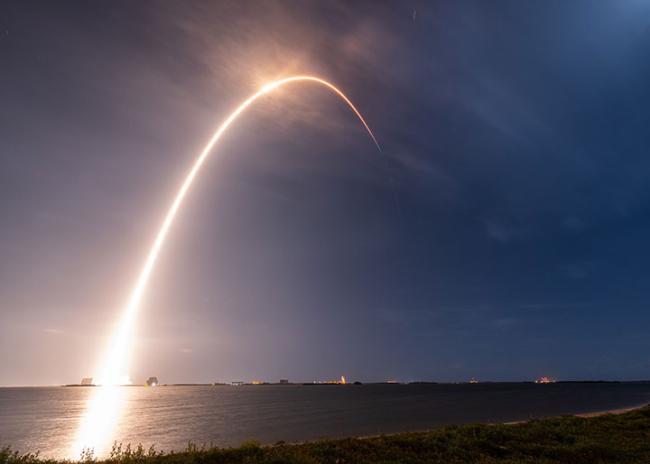After more than a decade of work, the TEMPO instrument has made it to space where it will soon begin observing air pollution over greater North America.

Cape Canaveral, FL – On Friday, April 7 at 12:30 a.m. ET, the motors of a SpaceX Falcon 9 rocket rumbled to life and ignited, lighting up the otherwise dark morning sky. The rocket blasted off from launch pad 40 at the Cape Canaveral Space Force Station in Florida. Its mission: to carry the satellite, Intelsat 40e — host of the NASA-Smithsonian instrument TEMPO — into space.
As the rocket soared off, a hush of silence fell upon Banana Creek, the primary viewing location of the launch, where hundreds had gathered in anticipation of the event. A white flash of light briefly lit the faces of the audience, revealing looks of awe and wonder. The group, primarily scientists, engineers and administrative staff from NASA and the Smithsonian, had spent the last decade constructing and preparing TEMPO for spaceflight.
"We were surrounded by people from Ball, Maxar, Intelsat, the Smithsonian and NASA," says deputy principal investigator of TEMPO Xiong Liu, an atmospheric physicist at the Center for Astrophysics | Harvard & Smithsonian who has been working on the project "since the beginning" in 2011. "Most importantly, my family was with me to watch TEMPO take off."
Thirty-two minutes after launch, the six-ton Intelsat 40E separated from the rocket. Signal acquisition occurred at 1:14 a.m. According to Intelsat executives, the satellite will begin firing thrusters in the next several weeks, to achieve geostationary orbit, an altitude of 37,000 kilometers — or 22,991 miles — above the Earth, where it will sit for the next several years focused on the North American continent.
"Our TEMPO slogan is 'It's about time,' which hints at TEMPO's ability to provide hourly air pollution data," says Liu. "After working on the TEMPO for more than 10 years, it is about time to launch TEMPO to produce real TEMPO data and start the new era of air quality monitoring over North America."
The TEMPO instrument will be commissioned — or activated — in late May or early June, with first light occurring sometime in August. Near real-time air pollution data is expected to begin in October, but the science team will focus on analyzing and validating the data in the first several months to ensure its accuracy, according to Liu.
TEMPO's observations will dramatically improve the scientific data record on air pollution – including ozone, nitrogen oxide, sulfur dioxide and formaldehyde – not only over the continental United States, but also Canada, Mexico, Cuba, the Bahamas and part of the island of Hispaniola.
"This marks a new era in our ability to observe air pollution over North America, including the entire continental United States," says Barry Lefer, TEMPO program scientist and tropospheric composition program manager for NASA. "It's also opening the door for us to work more closely with our international partners to better understand global air quality and its transport."
The TEMPO instrument was built by Ball Aerospace and integrated onto Intelsat 40E by Maxar.
The public can re-watch the launch of TEMPO here.
# # #
About the Center for Astrophysics | Harvard & Smithsonian
The Center for Astrophysics | Harvard & Smithsonian is a collaboration between Harvard and the Smithsonian designed to ask—and ultimately answer—humanity's greatest unresolved questions about the nature of the universe. The Center for Astrophysics is headquartered in Cambridge, MA, with research facilities across the U.S. and around the world.
Media Contact:
Nadia Whitehead
Public Affairs Officer
Center for Astrophysics | Harvard & Smithsonian
nadia.whitehead@cfa.harvard.edu
617-721-7371